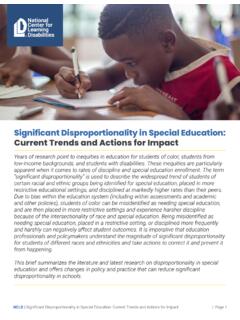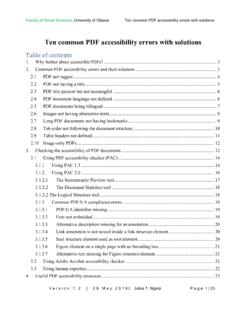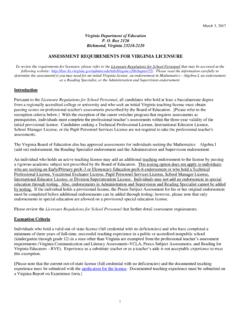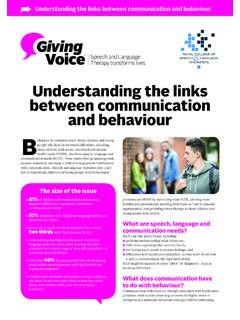Transcription of Evidence-Based Interventions for Children with Disabilities
1 Evidence-Based Interventions for Children with EDUCATION (SPED)BY KIMBERLEY SORENSONK imberley Sorenson has worked as a classroom teacher, administrator, and curriculum director for the Waterford Institute. She holds a BA from Harvard in the History of Science and Technology, an MFA from Vermont College in Writing for Children and an in instructional design and educational technology from the University of 2004, THE FEDERAL GOVERNMENT PASSED THE INDIVIDUALS with Disabilities ACT (IDEA). This act requires school districts to provide a free education that meets the needs of all Children , including those with physical, intellectual, and/or emotional Disabilities .
2 When those Disabilities threaten the child s ability to learn, school districts are required to offer free special education (SPED) services. Children are eligible for these services from birth through age 21. The Every Student Succeeds Act (ESSA) of 2015 continued the legacy of IDEA. Every state is required to have a Child Find office, which attempts to identify and to serve young Children who may have a developmental delay or disability. Families and/or their physicians can also request a free evaluation from their school district for their Children , beginning at age three. Typical Disabilities include Autism Spectrum Disorder (ASD), emotional difficulties, hearing and/or visual impairments, intellectual Disabilities ; motor impairment ; specific learning disability (dyslexia and/or dyscalculia); and speech or language impairment .
3 Disability is a natural part of the human experience and in no way diminishes the right of individuals to participate in or contribute to society. Improving educational results for Children with Disabilities is an essential element of our national policy of ensuring equality of opportunity, full participation, independent living, and economic self-sufficiency for individuals with Disabilities . Every Student Succeeds Act (ESSA)Once the school district has determined that a child needs SPED services, the district meets with parents to write an Individual Education Plan (IEP). The IEP explains the child s disability; defines specific, achievable learning goals; and lists the accommodations and services the child and family need to achieve those goals.
4 Since Children are most likely to make progress with the help and example of their peers, districts are instructed to place students receiving SPED services in the Least Restrictive Environment that is practical. Other terms for this are inclusion and (previously) is not a one-size-fits-all classification. Some Children need SPED services because their brains don t function as quickly or efficiently as their peers . Others have normal intelligence but struggle with physical, emotional, or specific cognitive deficits. Surely the supports they require will look very different, right?Well, yes and no. While some Disabilities require specific Interventions learning braille won t help Children wrestling with emotional difficulties it s also true that a handful of Evidence-Based Interventions help nearly all Children with Disabilities .
5 These Interventions help Children become more productive learners by reducing the demands on their Simple, Predictable Classroom EnvironmentPredictable simplicity is enormously helpful for Children who are struggling to manage a disability. They have so many things they are juggling that any unnecessary novelty they have to process and integrate overwhelms their cognitive capacity. Simplifying the learning environment works wonders. Remove any unnecessary posters, decorative items, and stimulating colors from your classroom. You don t want to give students a reason to consider anything but what you are trying to teach them.
6 When students must intentionally focus on verbal cues and instruction, it is helpful to turn off music that doesn t have a specific instructional purpose. It may help take the edge off your boredom as you go over the same skill you ve taught a hundred times, but it s a distraction for Children who are fighting to make sense of new material (Fisher, et al., 2014; Brophy & Good, 1986).Clear and Focused InstructionIt s easy to confuse the quantity of time, care, and craft supplies we lavish on a lesson, or the raptness with which students listen to a personal story, with instructional effectiveness. Student interest doesn t necessarily signal student learning.
7 The business world uses the phrase minimal viable product to help focus its efforts on what matters most. As you plan your lessons, put every activity to the clarity test: Will this direct my students to learning and practicing the target skill? Or is it something that is interesting and somehow related, but not actually part of the minimal viable product? Have fun with all of your students, but keep your instruction time as clear, simple, and predictable as possible (Allinder, 1994).Differentiated InstructionThough students with special needs enjoy interacting with their peers during collaborative, open-ended activities, they learn the most from explicit, slow-paced, and repetitive small-group instruction.
8 Consider dividing your instruction time into three parts: inclusive whole-class instruction; a period of practice and consolidation that varies according to the child s needs; and final, whole-group reflection. Use the practice period to re-teach the concept as explicitly and clearly as possible to your students with diverse learning needs, while middle-of-the road students practice and correct the new skill in pairs, and advanced students apply the skill to something they are learning in a different part of the curriculum. How can you find the time to plan for three kinds of practice? By simplifying the mode of your presentation and relying on well-understood classroom routines (Manship et al.)
9 , 2016; Chard et al., 2002).Routines and Behavioral AccommodationsMany candidates with special needs have poor executive function skills. These Children have difficulty organizing, planning, and accommodating change efficiently. Create and explicitly teach classroom rules and routines that help Children understand what they are supposed to do and how to do it. Then practice! Whether it s learning strategies for handling waiting or knowing what to do when they need help, Children take pride in knowing what they are supposed to do and then doing it. This is particularly helpful for Children who have difficulty managing their emotions.
10 Help them identify their triggers, then work together to find strategies for managing overwhelming feelings, like a quiet bottle or a pass to go out in the hall and get a drink (Diamond & Lee, 2011; Albright et al., 2011).Mastering Foundational SkillsRemoving distractions and teaching Children strategies for preventing costly melt-downs is a good beginning. But it s not enough to promote academic success. Key academic domains like reading and math depend on a small number of foundational skills that Children have mastered to the point of automaticity. The importance of these foundational skills was long overlooked, since most Children can pick them up incidentally.




